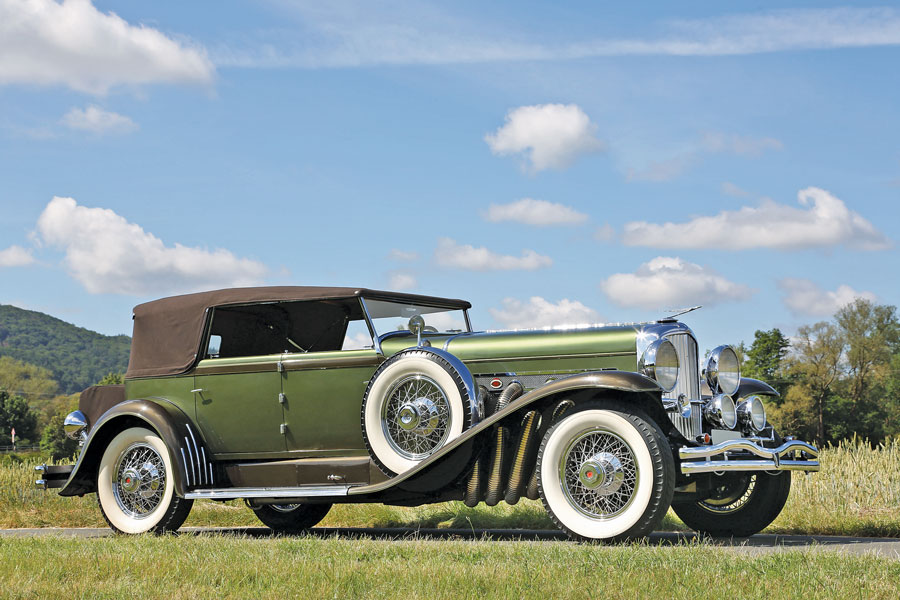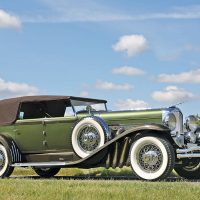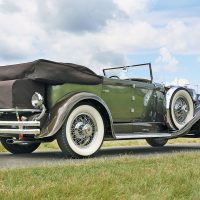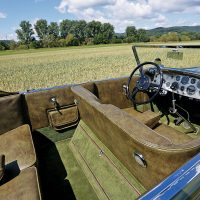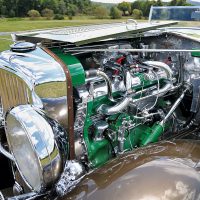- Offered from 30 years of enthusiast ownership
- Original short-wheelbase chassis, engine and coachwork
- Equipped with a supercharger built using original components
- Featured in Beverly Rae Kimes’ The Classic Car: The Ultimate Book About the World’s Grandest Automobiles
- Classic Car Club of America (CCCA) Full Classic
SCM Analysis
Detailing
| Vehicle: | 1929 Duesenberg Model SJ Convertible Sedan |
| Years Produced: | 1929–37 |
| Number Produced: | 480 |
| SCM Valuation: | $880,000 |
| Tune Up Cost: | About $3,500 |
| Chassis Number Location: | Left frame rail |
| Engine Number Location: | Bellhousing and connecting rods |
| Club Info: | Auburn Cord Duesenberg Club |
| Website: | http://www.acdclub.org |
| Alternatives: | 1929–32 Duesenberg Model J Murphy convertible sedan, 1929–32 Duesenberg Model J Murphy convertible coupe, 1932 Duesenberg Model J Derham convertible sedan |
| Investment Grade: | B |
This car, Lot 131, sold for $781,000, including buyer’s premium, at RM Sotheby’s Online Only Shift/Monterey sale held August 14–15, 2020.
Augie and Fred Duesenberg built some of the finest race cars of the early 1920s. Piloting a Duesenberg in 1921, Jimmy Murphy became the first American to win the French Grand Prix. The same year, famed World War I pilot and racer Eddie Rickenbacker achieved a top-10 finish at the Indianapolis Motor Speedway driving a Duesenberg. And in 1924, a Duesenberg with America’s first supercharged straight-8 engine actually won the Indy 500. Pretty impressive for two brothers who had never received a formal education!
Yet the Duesenbergs struggled to successfully market their exceptional machines. The Duesenberg Straight Eight Model A was a luxury automobile that was light, powerful and innovative. Perhaps too innovative, as the dual-overhead cams, four valves per cylinder and hydraulic brakes (an automotive first) resulted in a car that was far too expensive for even the upscale market. The limousine was priced close to $7,500 — twice the price of Cadillac’s Formal Sedan. Thus, in October 1926, Errett Lobban Cord added Duesenberg to his burgeoning automotive empire, acquiring the firm out of receivership.
“She drives a Duesenberg”
The Model A continued to be produced through 1927, until the Model J moved to center stage, introduced at the New York Auto Salon on December 1, 1928. This was a big, fast, gorgeous and impressively expensive car. The chassis had a price tag of $8,500, and adding the coachwork could easily double that figure. Duesenberg offered stunning in-house bodies designed by Gordon Buehrig, and customs were offered by a number of independent coachbuilders. The Model J was billed as “The World’s Finest Motorcar,” with advertisements showing artful images of obviously patrician men and women with the simple taglines, “He drives a Duesenberg” and “She drives a Duesenberg.”
The Model J was powered by the race-developed straight-8 that produced 265 horsepower, which was twice the output of any other American offering. It was certainly needed, as the massive cars, with their 142.5- or 153.5-inch wheelbases, weighed in at close to 5,000 pounds. A centrifugal supercharger increased power to 320, but this was an awkward arrangement, with the blower placed on a stalk that rises out of the right side of the crankcase, where at 4,000 rpm it delivered the air/fuel mixture at about 5 psi to the intake manifold on the opposite side. A refined rams-horn manifold for the supercharger was later developed that produced as much as 400 horsepower.
The early supercharged SJs were identified by a one-piece, eight-pipe steel external exhaust, but later models utilized four flexible pipes. Duesenberg offered the flexible pipes as an option for the early cars, and they were often installed on non-supercharged Model Js. Of the 480 Duesenbergs produced, only about 36 were originally supercharged SJs.
100-point perfection
The 1929 Duesenberg sold by RM Sotheby’s was one of about 45 convertible sedans produced by the Walter M. Murphy Company of Pasadena, CA, the most prolific of the independent Duesenberg coachbuilders. This is a beautifully proportioned car, with elegant and refined lines. In 1967 it was acquired by Al San Clemente, a prominent and robust New England collector, who played full contact hockey well into his 70s. He spent two decades restoring the car, originally a Model J, and decided to modify it with a supercharger. Upon completion, it received 100 points at a CCCA Grand Classic, although that was many years ago, when standards were quite a bit different than today.
Adding a supercharger is not a simple “plug-and-play” procedure. The original aluminum top portion of the supercharger was unstable, and it was not until the 1970s that technology was developed to reliably seal the porous metal. Longtime collector Leo Gephart produced many of the unobtainable parts and San Clemente scrounged the rest. The addition of a supercharger to a Model J Duesenberg does not add to the value, although we cannot find any evidence that it has an adverse effect, either.
On parade in PNW
San Clemente’s Duesenberg was sold to Pacific Northwest collector Tom Crook and was frequently seen in the area on CCCA CARavans and shows as it passed through the hands of several of the region’s collectors. It had more recently gone to Europe, where RM Sotheby’s seller consigned the car. (Coincidentally, when the car is repatriated, it will be returning to the Pacific Northwest under its new ownership.)
While the American car market has been a bit soft of late, that has not been the case with Duesenbergs. By the time this car returns to Cascadia and is placed in good running order, the new owner will have well over $800k invested. That won’t allow much of a profit in the near future if the new owner tires quickly of his prize, but it is doubtful that a sale would result in any loss, either. Call this deal fair to all and we’re sure the new owner will enjoy driving “The World’s Finest Motorcar.” ♦
(Introductory description courtesy of RM Sotheby’s.)
